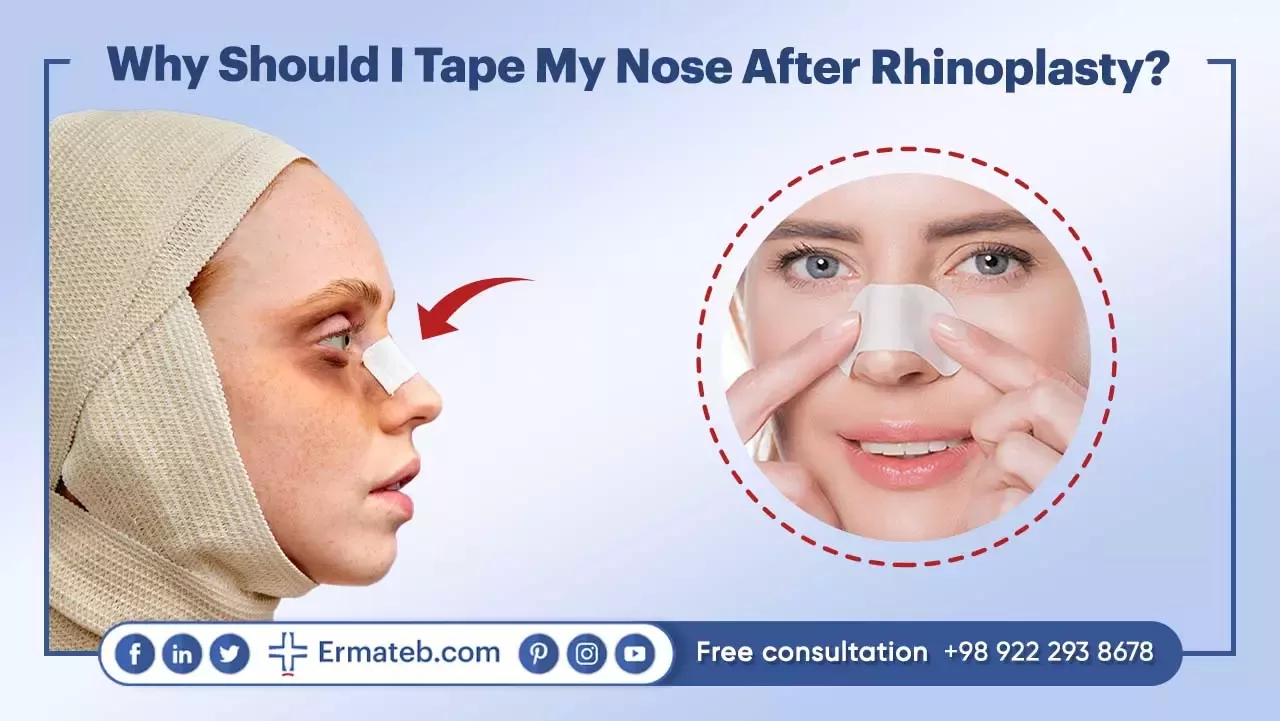
Following your rhinoplasty procedure, you might be inclined to believe that the journey is nearly over and you can neglect further care. However, it's important not to be too certain! After undergoing rhinoplasty, your nose endures significant swelling, and what better remedy than taping nose after rhinoplasty?
To achieve this goal, it is essential to adhere to the guidance and instructions provided by your doctor.
However, we have compiled some helpful information for you in case you are still uncertain. If you have lingering questions about the steps you should take to achieve a full and complete recovery after rhinoplasty, we highly encourage you to read this article.

After undergoing rhinoplasty, the burden of wearing a white bandage-like tape on your nose can be quite challenging.
The adhesive may cause itching and discomfort, while the conspicuous appearance of the tape might draw unwanted attention to your nose.
Given these concerns, you may want to give up on all the things, remove your nasal taping and never use it again at all.
It's important to note that the necessity of nose taping after rhinoplasty can vary depending on individual circumstances, because some surgeons consider nose taping as an integral part of the healing process and a vital aspect of post-operative care, while others view it as an optional practice.
Factors such as the patient's nose type and skin thickness also come into play when deciding whether to employ nose taping.
Actually, the use of nose tape becomes particularly important for individuals with thicker skin, as they tend to experience more pronounced swelling.
Regardless of the differing opinions on nose taping, it is crucial to diligently follow the instructions provided by your doctor.
Even if these instructions include an extended period of adhesive tape usage, spanning several consecutive weeks following the operation, it is important to adhere to these guidelines for optimal healing and to achieve the desired results of your rhinoplasty.
Your doctor's knowledge and personalized recommendations will help guide you in making informed decisions about the duration and necessity of nose taping in your specific case.

Following your rhinoplasty procedure, your doctor will likely recommend the use of nose tape. While some individuals may question its necessity, the purpose of nose tape is to effectively reduce and manage swelling, as well as to diminish the space between the skin and underlying bone, resulting in a more visible outcome.
Besides, taping nose after rhinoplasty is also recommended to help support the nasal tissues and promote proper healing. It can help control post-operative edema and provide stability to the newly shaped nasal structures
Therefore, if you desire to witness the improvements made to your nasal structure and achieve the desired final appearance following treatment, it is crucial to use nose tapes in a regular basis.

Nasal taping offers numerous advantages beyond facilitating a faster recovery and enhancing the likelihood of achieving improved and predictable outcomes. Explore below to discover the various benefits associated with this therapeutic and remedial approach:
Following a nasal surgery, you might encounter certain difficulties such as breathing issues, bleeding, and bruising, which are common side effects of the procedure.
These challenges arise from the modifications made to the internal structure of your nose, resulting in swelling both internally and externally, making it more challenging to breathe. Additionally, the delicate capillaries inside your nose may become sensitive and prone to bleeding.
Thankfully, the utilization of nose tapes can aid in expediting the recovery process and alleviating these side effects.
As previously highlighted, the primary and crucial purpose behind employing nasal tapes is to diminish swelling.
It is imperative to utilize these tapes due to the significant role they play in reducing the discomfort and impediment caused by nasal swelling, thereby facilitating the treatment and recovery process.
In addition to this, it is worth noting that swelling may persist even after 6-12 months post-surgery. By utilizing nasal tapes following a rhinoplasty, one can effectively manage the rate of swelling, ultimately expediting the manifestation of the actual results.
Another intriguing benefit of utilizing nasal tapes after undergoing rhinoplasty is that they serve as a visual cue for individuals to exercise caution and handle you with greater care.
You may find yourself in situations where you initially intended to engage in light-hearted banter with someone, only to suddenly realize that you should be mindful of a specific area on their body due to recent surgical intervention.
This serves as a reminder not only to yourself but also to others, prompting them to be mindful of their actions and interactions. It serves as a gentle warning that your nose is still sensitive and vulnerable to changes in shape and form if handled carelessly.
After undergoing rhinoplasty, many individuals express concerns regarding the potential occurrence of a drooping nose, as some may require a revision rhinoplasty to address this issue.
However, the utilization of nasal tapes can effectively diminish nose deformities and prevent nasal sagging.
By providing support to the nose and assisting in maintaining its shape post-surgery, nasal tapes play a crucial role in reducing the likelihood of a drooping nose and ensuring optimal aesthetic outcomes.

Based on the type of nose and the thickness of the skin, doctors and surgeons employ various techniques for applying nasal tape after rhinoplasty. But if you find yourself uncertain about how to properly tape your nose, we have provided clear instructions for your guidance:
In the initial stage, it is crucial to select the appropriate tape for your nose. While your doctor might recommend a specific thickness or type of nasal tape, the optimal choice for your nose, based on various experiences, may be 1/2-inch tape made by 3M. This particular tape is hypoallergenic medical grade paper tape which is really gentle on the nasal skin, even with repeated use. In fact, using 1/2-inch tape gives better results than thicker or thinner tapes.
Before starting to tape your nose, you need to clean and wash the area and the skin over your nose and cheeks with water and soap, or an alcohol pad.
The reason that you should do this prior to all the steps is to remove all the grease and oil or even make-up on your skin, that makes the nasal tapes to stick properly, otherwise, the tape will not have its usual function and will come off.
Prior to applying nasal tape, it is important to prepare by cleansing and washing the skin around your nose and cheeks with soap and water or an alcohol pad.
This initial step is crucial for eliminating any grease, oil, or makeup residue on your skin, as it may hinder the proper adhesion of the nasal tape.
forgetting to clean the area beforehand can result in the tape not functioning effectively and potentially coming off.
As previously stated, doctors and surgeons may utilize various methods when applying nasal tape, but they adhere to comparable principles.
Once you have completed the aforementioned steps, you should stand in front of a mirror to ensure accurate positioning of the tape. For added convenience, consider using a tape holder to hold the proper nasal tape.
After all, follow the instructions below:
To begin, the initial step involves placing the nasal tape on the bridge of your nose. Depending on the shape of your nose and your doctor's recommendation, he/she may advise starting from the tip of the nose. These tapes are designed to support the tip of the nose and prevent it from drooping.
To cover the bridge of your nose with the nasal tape, you will need to cut 3-5 pieces of tape, each measuring 2 inches (2-3 cm) in length. To initiate the sticking process, position the tape approximately 2-3 millimeters above the tip of the nose.
For the second layer, place it slightly above the first layer, ensuring that it overlaps with the previous layer and covers the upper part of your nose.
As you continue upwards, opt for shorter pieces of tape for a more organized outcome. Remember that each layer should overlap the one beneath it. Eventually, be sure to gently press the area when applying the tape and then, you can cut the extra part of the tapes with scissors.
During this phase, take a longer piece of tape and cut it to a length of 10-12 cm. Position it beneath the tip of your nose, ensuring that its central part is placed beneath the tip, while attaching its sides to the two sides of the nasal bridge. This will create a U-shaped form.
As previously mentioned, it is important to apply this U-shaped tape in a manner that does not obstruct and cover the nostrils. Additionally, be cautious not to cover the upper portion of the nose tip.
Depending on the type of surgery or the structure of your nose, your surgeon may recommend gently pinching the tip of the tape.
At this stage, you will repeat the first step and once again cut 3-5 pieces of tape. These pieces are to be placed over the previously applied tape, with the aim of layering them.
Ensure that the new pieces are positioned on top of each other, starting from the tip of the nose and extending towards the top. The goal is to have the pieces overlap with one another, providing a comprehensive coverage.
Once again, remember to apply gentle pressure to ensure proper adhesion of the tape layers.

Due to the increased sensitivity of your nasal tissue following surgery, it is crucial to exercise caution when removing the tapes for a period of approximately 2-3 months.
Based on this fact, simply pulling off the tape without any precautionary measures can be detrimental. Therefore, it is recommended to moisten and make the tape wet initially to facilitate easier separation from the nose.
Around two to three weeks after your rhinoplasty, it is advisable to change your nose tapes every other day or once every three days. Consequently, the method of tape removal becomes important.
Your doctor may even suggest showering every 2-3 days, as it can help moisten the tapes and cleanse the skin on your nose and cheeks.
As a result, it is recommended to thoroughly clean the area under the tape after its removal to ensure complete removal of any residue, promoting better adhesion and eliminating any dirt or adhesion present.

If you've undergone rhinoplasty surgery, your doctor may recommend the use of nose tape for a period of 1-3 months, depending on factors such as your nose type, skin thickness, soft tissue, and the healing process.
For individuals with a bony nose and thin skin, the prescribed duration of taping nose after rhinoplasty may be 1-2 months. However, those with a fleshy nose and thicker skin may need to use nose tape for up to 3 months, and in some cases, even 4 to 6 months.
If you find the nose tape comfortable and can confidently wear it for a few months, it is advisable to wear it continuously for at least 3 months.
Additionally, it is recommended to remove the tape during the day and give your nose a break for 4-6 hours. Your doctor might suggest wearing the nose tape at night and allowing you to remove it during the day.
To prevent swelling and maintain control over the size of your nose, it is recommended to wear nose tapes even during nighttime.
During sleep, the entire face tends to become puffier and more swollen. By using nose tapes throughout the night, you can help prevent this condition and promote proper healing and recovery.

As previously mentioned, to prevent excessive swelling of your nose following surgery, it is important to wear nose tapes for a minimum of 3 months.
Initially, it is recommended to wear the tapes continuously until the second week after surgery. For the remaining duration, wearing nose tapes during the night is sufficient, although if it is comfortable for you, you may choose to wear them throughout the day and remove them for short periods.
Eventually, when planning to spend time outdoors with your family or friends, it is advisable to wear nose tapes, as exposure to heat and sunlight can contribute to increased swelling. However, if you are attending a party, it is acceptable to temporarily remove the tapes for a couple of hours.

Following rhinoplasty surgery, it is necessary to wear a nose splint for one week, and during this period, it is important to avoid getting the splint wet.
Therefore, if you wish to bathe, it is advised to postpone it for a week and instead opt for a shower. While showering, take care to avoid letting water directly run over your nose and face. For cleansing your face, you can use wet wipes or cosmetic cotton wools.
Once the nose splint is removed, you should begin wearing nose tapes. Initially, when wearing them for the first time, it is recommended to keep them on for 4-5 days.
Subsequently, taking a shower or having a complete bath is the best way to facilitate the removal of the nose tapes, as the moisture will loosen them, eliminating the need to apply excessive pressure when taking them off.

Incorrectly taping nose after rhinoplasty is said when the nose is under the pressure of strong and rigid adhesives that are placed on the nose, or vice versa, the adhesive is so loose that you don't feel anything about its presence on your nose.
In fact, any of these mistakes can aggravate the complications of nose surgery or cause problems that we are going to explain them below.
Actually, nose taping can be defined in two general ways: loosening of the nasal tape and tightening of the nasal tape.
When you use nasal tapes, you should feel its pressure on your nose to some extent, otherwise, taping your nose is no different from not taping it. In fact, too much loosening of the nasal tape cannot have a special effect on reducing the swelling of the nose.
Therefore, to learn the correct use of nasal tape, you must receive the necessary training from your doctor. If you are worried about making a mistake with your nasal tape, you can leave it to your doctor to change it for the first few sessions.
Applying nose tapes incorrectly can be due to tightening it too much, which also causes wrinkles around the patient's nostrils, that can be clearly seen when the tape is changed.
Therefore, if you apply your nose tape too tightly, after removing it, you may face a completely disproportionate appearance in the nose, which, of course, is nothing to worry about and will disappear over time and by applying the nose tape correctly.
In addition to this, sometimes the patients apply the nose tapes on the one side of their nose tighter than the other, which can cause unilateral swelling of the nose (nose asymmetry) after surgery.
In the end, it should be understood that incorrect nose taping does not have the power to alter the shape of the nose. As previously mentioned, the purpose of nose taping is not to reshape the nose, but rather to reduce swelling, which is a temporary effect. Over time, typically within a year, the swelling naturally subsides and diminishes.

While many doctors and surgeons recommend wearing nose tapes for approximately 3 months, some patients have the misconception that using them for longer durations, such as 6 months or even a year, will lead to a smaller nose and prevent swelling. Additionally, certain individuals use nose tapes solely to hide their swollen nose and avoid facing it directly.
In fact, wearing nose tapes for more than the prescribed 3-4 months or an extended period of time does not impact the surgical outcome or the final shape of the nose. Moreover, it can potentially result in skin complications.
To avoid such complications, it is advisable to adhere to the recommended duration of nose tape usage as prescribed by your doctor, allowing the skin on your nose to breathe.
The reason behind why doctors recommend the use of nose tapes after rhinoplasty is to regulate and control swelling and promote faster healing. Although using nose tapes is not actually proved to be useful, they can potentially assist patients in achieving quicker visibility of the final surgical outcome and avoiding the following issues:
• Excessive inflammation of the nose
• Significant and high swelling
• Increased recovery period
• Formation of scars
• Drooping of the nose tip
• Cartilage failure

Previously mentioned, taping nose after rhinoplasty primarily addresses swelling and skin shrinkage, rather than shaping the nose.
If you observe any changes in your appearance when looking in the mirror, it is not due to the nose being reshaped, but rather a result of reduced swelling.

